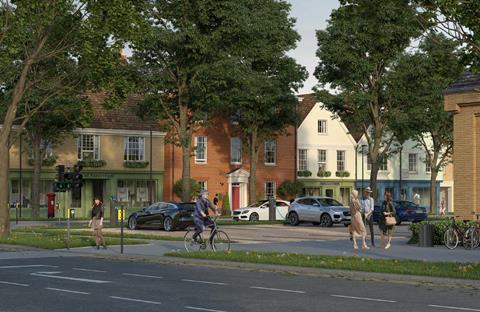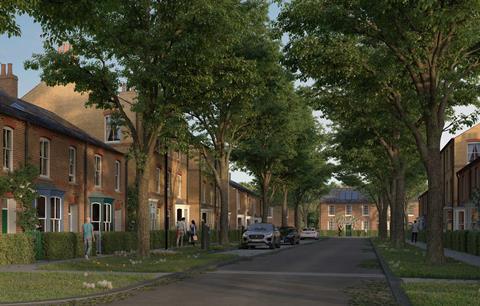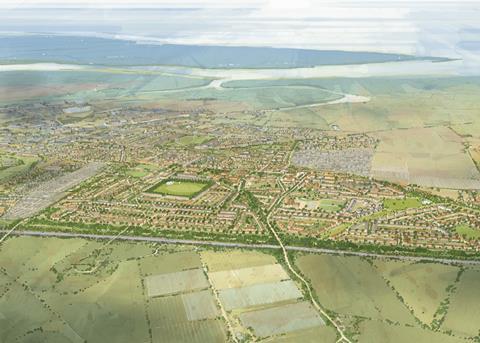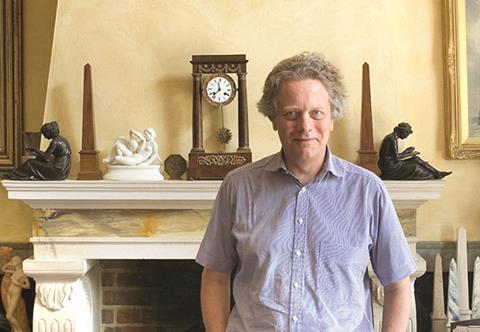The project team behind plans for a ‘Poundbury-style’ development in the Kent market town tell Tom Lowe why the scheme has been unfairly maligned in news reports about a supposed local revolt based on fewer than 30 objections

Ben Murphy is, frankly, livid. “It’s fascinating how misread this has been,” the estate director of the Duchy of Cornwall blasts down the phone from his kitchen. “It feels like the nationals need to take a look at themselves, to be honest.”
Last month, several national newspapers and broadcasters, including the BBC, The Times, the Telegraph and the Daily Mail, ran stories claiming that the duchy was facing a local revolt over its plans to build 2,500 homes in Faversham, Kent. This was despite the planning application submitted to Swale Borough Council receiving fewer than 30 objections at the time of the reports.

But the story was too good to resist. Much of the local opposition focused on the loss of prime agricultural land that would be incurred by the construction of the new homes, suggesting a certain hypocrisy on the part of climate champion Prince William, the owner of the duchy. It was “wilful ignorance” from the press, Murphy says.
“They are all falling for clickbait in the headline. And it’s like, are they really serving their readership well?” he asks. “They’re not looking at this intelligently. And that, I think, is a disservice to their readership.”
When BD spoke to Murphy, the number of objections had increased to about 40. For a scheme of this scale, which will increase the historic market town’s population of around 20,000 by roughly 12%, these numbers could be considered, if anything, a “success”, Murphy believes.
Obviously we work for someone that’s high profile, so it’s easy to get in the press, if you want to talk about us and our scheme
Ben Murphy, estates director, Duchy of Cornwall
“A 2,500-home urban extension of a beautiful, historic ancient town that everyone loves… and it’s only got 40 objections, despite it being in the national press for two weeks?”
He may have a point. Sellar’s planning application to partially demolish Liverpool Street station, although not residential, has racked up more than 2,200 objections since it was made public last October. The City of London’s plans to redevelop the former Museum of London site near the Barbican have been hit by nearly 1,000 objections.
Of course, these are very different schemes from Faversham, but it gives a sense of how much opposition applications can amass when they stoke up real controversy.
Create Streets founder Nicholas Boys Smith says the level of objections does not suggest a major backlash. “I’ve certainly seen schemes proposed by people that have got many more objections than that. And, if people were really up in arms, you’d certainly be in the hundreds, if not thousands.”

So, why has the Duchy of Cornwall’s plans whipped up such a media storm, and why does it matter? Murphy argues that the 687-year-old landowner is an “easy target”.
“I don’t mean to say, ‘let’s get the violin out for the Duchy of Cornwall’, but partly it’s because of who we are, I think. Obviously we work for someone that’s high profile, so it’s easy to get in the press, if you want to talk about us and our scheme.”
For Murphy, the press attention has been particularly galling because of what it suggests about the duchy’s attention to sustainability, one objector saying the loss of agricultural land was “literally taking food out of our children and grandchildren’s mouths”.
“[The duchy] is very serious and sincere in their thinking about sustainability,” says Boys Smith. “It’s not greenwash from the last five years. It’s long standing and actually goes back to the early speeches of the then Prince of Wales [King Charles], made 30 years ago, which were remarkably prescient.”
> Also read: Duchy of Cornwall’s 2,500-home Kent plans progress
It has also stung because of the efforts taken by the project team during years of consultations to ensure local support for the plans. The proposed homes have been designed by Ben Pentreath, the architectural designer behind much of the Poundbury development in Dorchester, which has been celebrated as an example of how to sensitively extend a historic town.
The Faversham scheme has followed this example, with a design manual aiming to seamlessly integrate the new homes into the fabric of the town by mimicking local styles, from the medieval era to the 1970s.
It is significant that design is barely mentioned in the objections, the vast majority of which focus on the traditional concerns of increased traffic and loss of green land. But this is a scheme which has been partly driven by the local council out of a need to build more homes.

Murphy describes the duchy as almost a “reluctant bride” in pursuing the development. “If this is not what the local authority deem is the most appropriate location to expand this town, then we won’t,” he says. “But we wouldn’t be doing this if we weren’t supported through policy and we were encouraged to bring this forward.”
The row goes to the core of the UK’s housing problem: when there is a chronic shortage of new homes, where are they going to be built? Labour has promised 1.5 million new homes during its first five years in government if elected, along with the construction of a wave of new towns and major extensions of existing communities. To do this, party leader Keir Starmer has pledged to “bulldoze” the planning system and has proposed creating a new “grey belt” land class to encourage development on poor quality areas of the green belt.
Murphy has attempted to achieve the same ends in the current system, aiming to win support from locals by prioritising sustainability and amenable design while appealing to common sense.
He argues that the duchy is “putting its head above the parapet and saying, ‘well, let’s try and make this as sustainable as we can because, yes, it’s grade one and two farmland’.
You can’t build all the homes on brownfield, partly because it’s not always viable, but then maybe because it’s not in the right location where the housing is needed
Ben Murphy, estates director, Duchy of Cornwall
“But Kent has an abundance of grade one and two land. And you can’t build all the homes on brownfield partly because it’s not always viable, but then maybe because it’s not in the right location where the housing is needed.”
Not everyone on the project team has been as rattled by the press coverage as Murphy. Pentreath is sitting in a car in “deepest darkest Somerset” with Kim Wilkie, the landscape designer on the Faversham scheme.
“I didn’t really have too much reaction,” he tells BD cheerfully over a choppy phone signal. “When I saw some slightly Daily Mail clickbait kind of headlines, I was like ‘OK, here we go again’. It just doesn’t bother me.”

Pentreath has learnt how to brush off public outrage after going to consultation events where he would be “standing in a room with 200 people who are sort of like a mad mob screaming at me”. At one meeting in Truro for another Duchy of Cornwall scheme, people had been “so crazy that you almost couldn’t believe what they were saying because they were so mad”.
> Also read: How the Duchy of Cornwall’s Faversham plans are putting ‘building beautiful’ to the test
“It was before the days of Twitter and Donald Trump, but it was on about the same level of hatred,” he says. “Unlike social media, where people say crazy things that they wouldn’t actually mean because they’re hiding behind keyboards and a screen and it’s not human.
“The weird thing is, you can go to a public consultation event and it actually is human, like it’s actually me. I’m a person with feelings.”
This did not happen in Faversham, Pentreath clarifies. Most of the people he has spoken to at meetings over the past six years have been “really keen to be informed” and “not shouty”, he insists. “It has been a very different experience to how it’s been portrayed.”
The duchy could not have gone to greater lengths with both people in Faversham and with the press to explain what’s happening and why
Ben Pentreath, architectural designer
Even concerns over increased traffic – a staple of local ire in planning consultations – has been less pronounced than the objections might suggest. Analysis by urban planning consultant Space Syntax found the scheme would have 20% fewer car trips than an average development of the same size, and a high level of walkability.
Wilkie adds that the area is also “one of the most logical sites to put houses on”, given that it is bounded by the motorway and the A2 while fitting neatly into the structure of Faversham itself. This is another element of the development process which was ignored by the press reports, according to Pentreath.
“The duchy could not have gone to greater lengths with both people in Faversham and with the press to explain what’s happening and why,” he says. This includes the choice of traditional design, which had been the clear winner in a consultation questionnaire answered by hundreds of locals.
“Genuinely, the project is fantastic. It’s completely amazing,” Pentreath says. “It’s a perfect model of what bringing development to a threatened town like Faversham should be about – which is why there are a lot of people in Faversham who are very supportive and very aware of how much trouble and effort the duchy has gone to.”
Regardless, the persistence of the holy trinity of traffic, loss of green land and pressure on local services in the objections highlights the limits of what inoffensive design can achieve. Classicist architect Robert Adam sees getting locals on side as a “political problem, not a design problem”.
Adam is working with Boys Smith on the government advisory panel Office for Place, which is aiming to find ways of smoothing the construction of new homes in the planning process.
“Everyone knows that we need more houses,” Adam says. “Everyone knows that their children can’t afford to buy a home. But, when it comes to it being anywhere near them or affecting their life, they’re not prepared to have it.”

Like Pentreath, Adam has also had experiences in consultation meetings he would rather forget. Once, a man “nearly came to blows” with him, getting extremely close and shouting in his face.
“It’s almost legendary,” Adam says. But he is also sympathetic to what lies behind such strong feelings.
People recognise the need for development – but they want it to be good development as opposed to bad development. I do think attitudes are shifting
Ben Pentreath, architectural designer
“These are people who believe, rightly or wrongly, they are protecting their way of life and their property rights. These are pretty fundamental things.
“The problem is that people can get themselves into a state where nothing will dissuade them.”
Pentreath believes that public attitudes are starting to change, however, partly due to the experience of younger generations – and their parents – who are unable to get on the housing ladder because of unattainable property prices.
And the feedback posted by readers beneath some of the news reports seems to bear this out. The most-liked comment under The Times’ story came from a Faversham resident who said he lives less than five minutes’ walk from the site and will ”doubtless be subject to construction noise and disruption for the next two decades”.
But he adds: ”The article would have me as a minority view, and I may well be. But I will give this development my full support as ultimately it will enhance and improve the town I lived in and loved my entire life.”
Pentreath says: “Twenty-five years ago, I would say that almost anywhere you went there was a blanket, very strong dislike of development, and it used to be quite bruising.”
“Now I really find that people recognise the need for development – but they want it to be good development as opposed to bad development. I do think attitudes are shifting.
“It’s a big national debate, isn’t it? And I think people have sort of grown up about it.”













No comments yet